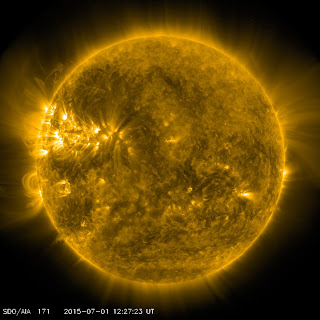Finally, I come to the point where limb darkening actually is not 'darkening' anymore. I should rather say limb brightening here. In the figure you can see the brightness across the solar disk again normalized to the value at disk center. However, this time you see that the Sun is brighter on the edges than it is in the center.
I generated this plot from SDO images like the one on the left. They show the Sun in the extreme ultraviolet at a wavelength of 17.1 nm. At these short wavelengths the disk is very inhomogeneous and you see a lot of loop structures which show the magnetic field of the Sun. Like in the last blog on SDO 1600, this is not the photosphere we are seeing; it's not even really the chromosphere anymore, but more like layers above that. Here we start to see the corona of the Sun.
In this high-energetic wavelength regime the Sun has no sharp edge. The top panel shows how the brightness goes down after the peak at the edge, but it does not drop down to zero like in the other images I showed in previous posts. The bright loops extend far into outer layers of the Sun and you still get a significant amount of light from there.
Magnetic lines are connected to the activity of a star. The more active a star is, the more of these bright inhomogeneous structures it should have in its outer atmospheric layers. Like spots these structures rotate with the star and change all the time.
For wavelengths showing limb brightening, exoplanet transits would look very different for what we see in the visual or infrared. Transits can change significantly from one to the other because the magnetic structures change. Also, contrary to the visual wavelengths, the transits are deeper at the edges than in the center. However, transits at these short wavelengths (far-UV, EUV, or even X-rays) are very hard to detect.

